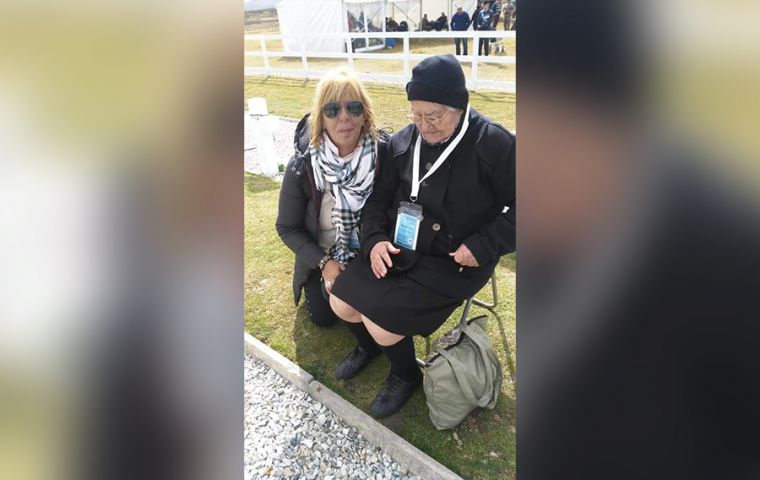MercoPress. South Atlantic News Agency
Argentine writer who pointed out cemetery inconsistencies at peace because families will find some comfort after all
 Panero was alongside Private Aguirre's mother at Darwin in 2017
Panero was alongside Private Aguirre's mother at Darwin in 2017 Argentine writer Alicia Panero has been for quite some time now the closest thing to an answer to relatives of fallen unidentified Argentine combatants in the 1982 conflict have had.
“Grave C1.10 should have been reopened in 2017,” Panero told MercoPress in a telephone interview Thursday. It was not, because in 2004 when the new Argentine Military cemetery in Darwin”was set up, names of Argentine Air Force soldiers were added to that one-casket structure containing remains of at least five Gendarmería Nacional operatives.
In other words, “since there were names on it” those buried in grave C1.10 were not among the ones “known only by God.” Under those circumstances, the unearthing of those remains did not fall under the scope of the agreement signed in late December 2016 among the governments of the United Kingdom, Argentina, the Falkland Islands and the International Committee of the Red Cross (ICRC).
But Panero and the families involved knew better. “I've always trusted (British Colonel Geoffrey) Cardoso's report,” which specified that the human remains in grave C1.10 were from the Puma Helicopter crew which fell on May 30, 1982, at Mount Kent and “not to the Air Force soldiers who had died 80 kilometres from there and who were identified in 2017 as lying in individual tombs,” she explained MercoPress while she was unable to explain to herself 2004 mislabelling.
“They tried to make me look as if I had lost my mind,” whenever she sought help from Argentine authorities to mend things up and bring peace to the families involved, “because they went through two phases of mourning; one after actual death during the war and the other when they could not find out about the remains” of their loved ones, she added.
In fact, Panero highlighted that most of the data she had collected was public access information supplied to her from British sources and archives.
In addition to Cardoso's work, Panero underscored both the endorsement she received from then British Ambassador Mark Kent as well as the Falkland Islanders Governement' concern towards humanitarian issues, as opposed to the vague response from Argentine authorities, which was also why she had been approached by the families in the first place.
“Had it not been for Cardoso, they would have never been able to identify not 115 but just one body,” she said regarding the ICRC's 2017 humanitarian campaign, which left only seven bodies nameless when their DNAs did not match the samples on the forensics database.
Now that works are underway at grave C1.10, Panero said she hoped similar actions will take place soon regarding grave B4.16, which contains the remains of two nameless soldiers as per the Cardoso document, although it bears the names of five members of a fallen Argentine Air Force Learjet crew.
Identifying the bodies “brings me peace” that these families shall not have to go through another episode of mourning, Panero admitted. “I was there when these mothers found out where their loved ones were buried and I know they died shortly after that, and I know they died in peace,” she went on.
“I want to be there when the new plaque is set in place at grave C1.10. Having helped identify these soldiers is the most significant thing I've ever done in my life, second only to becoming a mother myself,” she stressed.




Top Comments
Disclaimer & comment rulesCommenting for this story is now closed.
If you have a Facebook account, become a fan and comment on our Facebook Page!